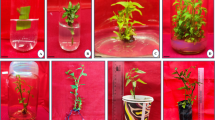Abstract
The effect of brassinolide (BL) on cultured calluses of Spartina patens (Ait.) Muhl. (Poaceae), a halophyte monocot was studied. BL at 0.03–0.04 mg l−1 at fixed concentrations of IAA (0.2 mg l−1) and BA (3.0 mg l−1) added in MS medium increased the ratio for fresh weight (CIRFW) to dry weight (CIRDW) by 96–111% and 235–326%. Similarly, in callus regeneration capacity, BL at 0.03 mg l−1 was most effective, increasing the shoot regeneration ratio (SRR) by 425%. BL at 0.04 mg l−1 had not such an increasing effect as BL at 0.03 mg l−1, which increased SRR by 79%. However, BL at 0.005 mg l−1 promoted regenerated shoot growth most significantly, increasing the shoot height increasing ratio (SHIR) by 395% after a 40-day culture. BL at 0.05 mg l−1 was least effective in the callus regeneration and regenerated shoot growth, decreasing SRR by 27% and SHIR by 52%. Present results suggest that BL at 0.03 mg l−1 is suitable for the callus growth and shoot regeneration, while BL at 0.005 mg l−1 effectively enhanced the regenerated shoot growth.
Similar content being viewed by others
References
Clouse SD, Zurek DM, McMorris TC & Baker ME (1992) Effect of Brassinolide on gene expression in elongating soybean epicotyls. Plant Physiol. 100: 1377-1383
Li XG, Seliskar DM, Moga JA & Gallagher JL (1995) Plant regeneration from callus cultures of salt marsh hay, Spartina patens, and its cellular-based salt tolerance. Aquat. Bot. 51: 103-113
Kim SK, Chang SC, Lee EJ, Chung WS, Kim YS, Hwang S & Lee JS (2000) Involvement of brassinolides in the gravitropic re-sponse of primary root of maize. Plant Physiol. 123: 997-1004
Mandava NB (1988) Plant growth-promoting brassinolides. Ann. Rev. Plant Physiol. Plant Mol. Biol. 39: 23-52
Mitchell JM, Mandava NB, Worley JF, Plimmer JR & Smith MV (1970) Brassins - a new family of plant hormones from rape pollen. Nature 225: 1065-1066
Murashige T & Skoog F (1962) A revised medium for rapid growth and bioassay with tobacco tissue cultures. Physiol. Plant. 15: 473-497
Stokes T (2000) BRInging light to hormone receptor activation. Trends Plant Sci. 9: 366
Yang YH, Zhang H & Cao RQ (1999) Effect of brassinolide on shikonin formation in cultured Onosma paniculatum cells. J. Plant Growth Regul. 18:89-92
Yokota T (1997) The structure, biosynthesis and function of brassinolides. Trends Plant Sci. 2: 137-143
Yokota T (1999) Brassinosteroids. In: Hooykaas PJJ, Hall MA & Libbenga KR (eds) Biochemistry and Molecular Biology of Plant Hormones (pp.277–293). Elsevier Science B.V., Amsterdam, The Netherlands
Zurek DM & Clouse SD (1994) Molecular cloning and characteri-zation of a brassinolide-regulated gene from elongating soybean (Glycine max L.) epicotyls. Plant Physiol. 104: 161-170
Author information
Authors and Affiliations
Corresponding author
Rights and permissions
About this article
Cite this article
Lu, Z., Huang, M., Ge, DP. et al. Effect of brassinolide on callus growth and regeneration in Spartina patens (Poaceae). Plant Cell, Tissue and Organ Culture 73, 87–89 (2003). https://doi.org/10.1023/A:1022665210113
Issue Date:
DOI: https://doi.org/10.1023/A:1022665210113




